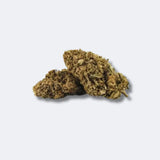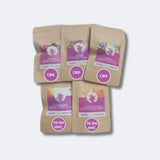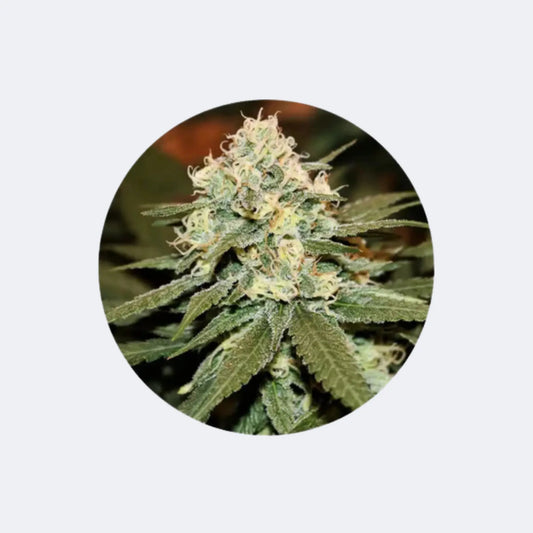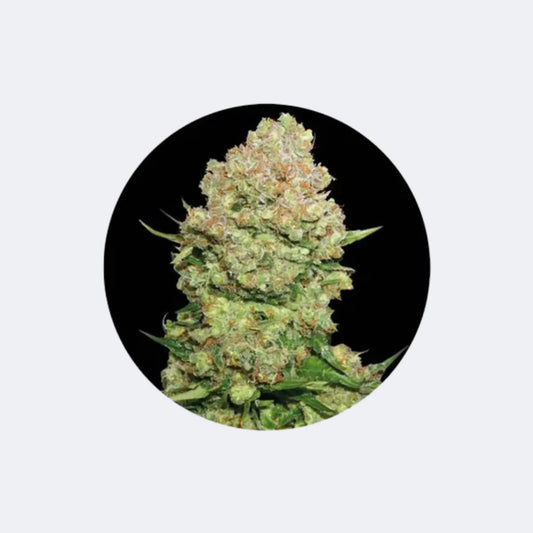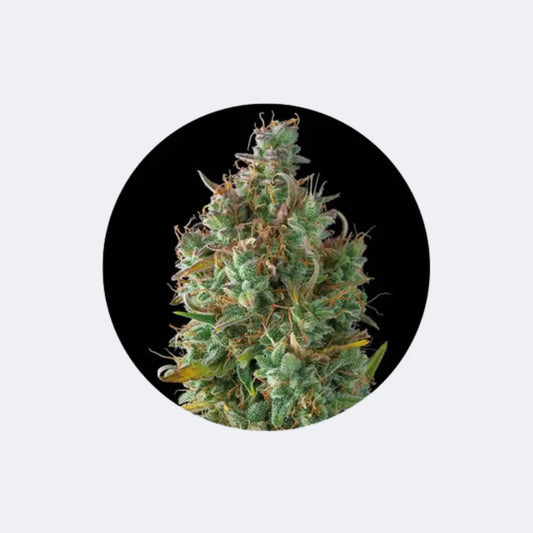
Plant or foliar sprays in cannabis cultivation
Andreas LeschkeShare blog post
Why spraying weed can be vitally important!
1. Basics
To understand why foliar sprays can be so important for growing your own marijuana, you should first discard the false idea that plants feed through their roots and realize that the roots are just a transport medium to transport nutrients to the leaves so that they can then prepare food for the plant through photosynthesis.
It is much more realistic to compare a leaf with a kitchen, where nutrients are supplied via the roots, but just as in a kitchen, the food (nutrients) that are within easy reach and therefore more quickly available are also used.
In addition, the nutrients that are made available directly to the leaves do not have to be processed by microorganisms first, as is the case with organic nutrients in the soil, so that the roots are even able to absorb them, but can be used directly by the leaves.
The processing of organic nutrients by microorganisms does have the advantage that it is almost impossible to over-fertilize plants with organic fertilizers, since the nutrients first have to be processed by the microorganisms and these usually do not manage to provide more micronutrients for the roots than the plant needs; however, it also has the disadvantage that this process takes several days, so that any relief from deficiency symptoms in the plant is only noticeable after a few days if the plant is only supplied with the additional nutrients it needs (nitrogen, Cal/Mag, phosphorus, etc.) via the soil.
The roots certainly make up the majority of your plants' nutrition, but the leaves are able to cover about 20 to 30% of the plants' total nutrition, which in my experience is a very large proportion if you want to get the most out of your miracle plants.
Knowing that your plants' leaves are capable of absorbing and processing both micro and macronutrients, you will not only be able to combat problems such as deficiencies, mold, or parasite infestation much more effectively with foliar sprays, but you can even accelerate the growth and flowering of your magical plants with the right foliar sprays.
It is important to note that the ideal pH value for foliar sprays should be between 6 and 7 for organic cultivation and between 5.5 and 6.5 for hydroponics (cultivation in water) so that the leaves can absorb it.
By now it should be clear to everyone why foliar sprays can be so important, but it should be noted that the direct absorption of nutrients also carries the risk of oversupply, so they should be used carefully and in moderate doses.

2. How and when to use foliar sprays
Due to the fact that we spray our girls until they are damp or wet by using leaf sprays, we have to keep in mind that there is a certain risk (e.g. in the indoor tent from LED or outdoors from the sun) that we could burn our ladies.
Therefore, it is recommended to only use foliar sprays when the plant is not directly exposed to LED light or the sun, because otherwise water beads on the leaves create a magnifying glass effect, which concentrates UV light and thus burns the leaves.
In addition, both in direct sunlight and in the direct LED light in the grow box, the time window in which the leaves can absorb the spray is very short, as the moisture on the leaves evaporates too quickly.
It is generally advisable to spray the plant only when the sun is setting, or has already set, in outdoor cultivation, or in an indoor tent, immediately after the lights have gone out.
In certain cases where only the lower part of a plant is affected by a nutrient deficiency, e.g. nitrogen deficiency, it is also possible to spray the parts of the plant that are in its own shade to bring about faster relief.
If the plant is large enough to provide shade for itself, there is nothing wrong with it during the light phase, as no direct UV light shines on the sprayed area.
The period during which plant sprays may be used extends until the third week of flowering. If you continue to spray the plant with fertilizer or other products after this time, there's a high risk that residues will end up in the flowers or, in the worst case, even mold could form in them.
However, during the entire vegetative phase until the end of the 2nd week of flowering, it is not a problem, as the plants have enough time to process and break down the sprayed agents until the end of flowering.
3. The most important plant sprays for grindgrass growers
Before I introduce different types of plant sprays, it is important for me to first point out that you can spray ANY nutrient that the plant needs directly onto the leaves of the plant or onto the plant itself, for example to remedy a nutrient deficiency.
For example, if you want to correct a nitrogen deficiency in a plant, you can spray the leaves of the affected plant with a coffee grounds solution and, with the help of nitrogen fertilizer in the soil, the problem will be solved a few days faster than without the foliar spray!
Water as a plant spray:
Even if it sounds banal to just spray your plant with water, you can still do something good for your loved ones.
Mineral water usually contains calcium, magnesium, sodium, and potassium. Regularly spraying your skin with water can help prevent a potential CalMag deficiency.
Furthermore, if the humidity is too low, it can be increased by spraying water (works best in an indoor tent or greenhouse).
CALMAG as foliar spray:
As soon as a Cal/Mag deficiency occurs that you want to correct, a Cal/Mag foliar spray should also be used in addition to fertilizing the soil if you want to correct the deficiency quickly and effectively.
Mix 15ml of Cal/Mag fertilizer with one liter of water and spray it onto the leaves weekly until the problem is resolved.
Phosphorus as a foliar spray:
The need for phosphorus increases rapidly from the beginning of pre-flowering. Therefore, it is recommended to administer phosphorus to the weed ladies in the form of a foliar spray solution from pre-flowering until the end of the third week of flowering, in addition to the phosphorus-containing flowering fertilizer in the soil, to achieve stronger flowering.
Whether you buy a ready-made spray or make your own using a solution is up to you. In any case, a phosphorus deficiency can be visibly combated within two days using a phosphorus spray like this.
Lavender and mint oil as plant spray:
This is a type of protective spray. The scent of lavender and mint oil acts as a deterrent to most parasites that might infest our beloved little flowers.
For this, you need an essential oil with the appropriate scent, which, of course, should be 100% natural and not synthetic. Due to the potency of these essential oils, 1 to 2 drops per liter of water is sufficient to create a solution that can be sprayed on plants to protect them from pests.
Essential oils in foliar sprays should only be used until pre-flowering. Once the plant begins to develop its buds, such products should be discontinued.
The protective effect lasts for about 7 days.
Neem oil as a foliar spray:
Neem oil, as a foliar spray, is one of the most effective means of combating parasites. This all-natural insecticide combats and repels caterpillars, spider mites, aphids, slugs, and a whole host of other parasites in such a gentle way that it neither endangers nor harms beneficial insects like bees. The solution is mixed at a ratio of 1 (neem oil) to 25 (lukewarm water) and sprayed over the entire plant.
This process should be repeated every 7 days until the parasites have been eliminated.
Neem oil can also be used effectively to combat mold. As with parasite control, we mix a solution in a ratio of 1 (neem oil) to 25 (lukewarm water), which we spray on the affected areas.
Alternatively, you can dab stubborn mold stains with a cotton swab soaked in neem oil to remove it.
Hydrogen peroxide (H2o2) as a plant spray:
Like neem oil, hydrogen peroxide can be used to prevent and eliminate mildew. It is also extremely potent, and only 1 to 2 drops per liter of water are sufficient to create a solution.
Hydrogen peroxide is so potent that it not only eliminates mold and mildew, but can also completely destroy fungal infections.
The solution is sprayed onto the plants weekly until any mold, mildew, or fungal infections are eliminated. Please note that the solution should be mixed anew every week, as H2O2 in water naturally degrades within four days.
Baking soda solution as a foliar spray:
With one liter of water and 2 teaspoons of baking powder or baking soda, you can mix a very effective foliar spray that can be used to combat mold and parasites.
The process should be repeated weekly until the mold or pests are eradicated. Using baking soda as a foliar spray is only recommended until pre-bloom. However, it should not be used after the flowering period.
Colloidal silver as a plant spray:
To breed feminized ganja seeds from feminized genetics, the cannabis seed industry uses colloidal silver to make the plants hermaphrodite, so that this pollen forms sacs that can be used to pollinate female plants.
Due to the fact that this form of foliar spray was mentioned in my last blog post
"Getting cannabis seeds from female Ganja ladies"
has been discussed in detail, I refer to that article instead of repeating it here.
"Alfa Boost" as a plant spray:
The product "Alfa Boost" is a multifunctional product that can be used both during the seedling phase, for faster germination and rooting, and throughout the vegetation period and throughout the flowering phase to give the plant stronger and faster growth through the plant growth hormone "Triacontanol".
Typically, "Alfa Boost" is added to the soil throughout the plant's life cycle to boost the plants with "Triacontanol," which is supposed to result in more robust and healthier plants, but also produce higher yields.
In addition, it is recommended to spray the plant once a week during the entire vegetative phase until the end of the second flowering week, where the manufacturer recommends a mixing ratio of 10 ml of "Alfa Boost" to one liter of water during the vegetative phase and 20 ml of "Alfa Boost" to one liter of water during the pre-flowering phase until the end of the second flowering week.
According to rumors, this product, especially when used as a spray from pre-flowering until the end of the second week of flowering, is supposed to cause flower production to explode.
I must add that even though "Alfa Boost" has the word "All-In-One" on the bottles, it does not replace the plant fertilizer (NPK fertilizer), but is merely an additive.
I can't yet judge for myself whether "Alfa Boost" is truly the potent miracle cure I've often heard. But as a blogger at CBD-HEXE, I see it as my duty to give this booster a real chance in my next grow, where I'll test it in direct comparison with three identical strains.
In this test, one of the three females will receive Alfa Boost both in the soil and as a foliar spray. Another female will receive it only as a soil additive, and a third will receive no Alfa Boost at all. For everything else (fertilizer, HST, and LST), all three genetically identical cannabis plants will be treated the same.
It will take a few months until I have all the results, as I currently have a grow running for about 4-6 weeks, but I will be able to provide you with realistic comparison values during the next "Grinsegrass Run" regarding the yield and quality of the flowers with and without "Alfa Boost".
We thank the author Jorge Rieger for this blog post on the topic of "Plant and foliar sprays in cannabis cultivation." Feel free to follow him on his Facebook account. --> Click here
